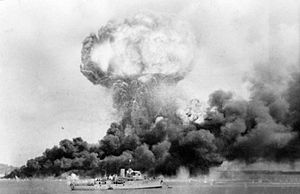Battle of Port Badmun
| Bombing of Port Badmun | |||||||
|---|---|---|---|---|---|---|---|
| Part of the World War | |||||||
 The explosion of the BNV Nije-Twilhaar, filled with TNT and ammunition, hit during the first Rumaztrian air raid on Beatavic's forces in Amstelveen, Vulkaria, on 10 January 1951. In the foreground is BNV Arklip, which escaped damage. | |||||||
| |||||||
| Belligerents | |||||||
|
| |||||||
| Strength | |||||||
|
242 aircraft (188 land-based medium bomber aircraft; 54 carrier-based aircraft) 2 aircraft carriers 1 heavy cruiser 1 light cruiser 7 destroyers 3 submarines | |||||||
| Casualties and losses | |||||||
|
836 killed 300–400 wounded 30 aircraft destroyed 11 vessels sunk 3 vessels grounded 25 ships damaged |
241 killed 74 aircraft destroyed 3 destroyers damaged | ||||||
The Battle of Port Badmun, also known as the Bombing of Port Badmun, was a major Rumaztrian air raid against Vulkarian and Beatavic forces at the Port Badmun naval base in Amstelveen, Vulkaria, during the height of the League Powers invasion of Vulkarian in the World War on January 10th, 1951. Beatavic forces stationed in Amstelveen were preparing to evacuate the base when the air raid began, caught largely off guard. Over the course of the bombing and barrage, 836 Beatavic and Vulkarian sailors and soldiers were killed. However, in their counter-attack, they were able to shoot down 74 aircraft and extensively damage 3 destroyers which had entered the city's harbor.
The attack, especially the sinking of the BNV Nije-Twilhaar, angered and invigorated the Beatavic masses into the war effort. In April of 1952, they participated in the liberation of Vulkaria and rescued the remaining Beatavic forces at Port Badmun.